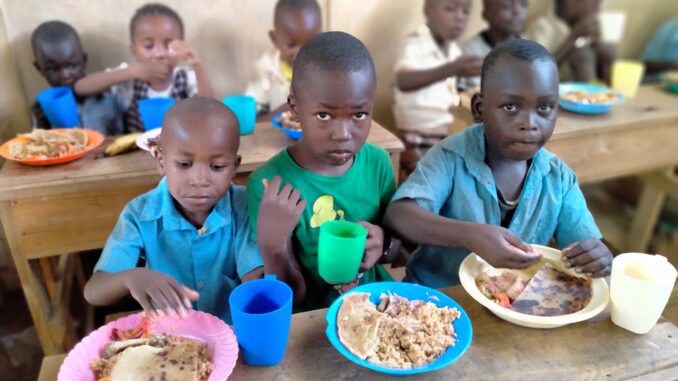
By
Top 10 hungriest African countries in 2022
According to the 2022 GHI, Hunger is at alarming levels in 5 countries—Central African Republic, Chad, Democratic Republic of the Congo, Madagascar, and Yemen— and is provisionally considered alarming in 4 additional countries— Burundi, Somalia, South Sudan, and Syria. In 35 countries, hunger is considered severe, based on 2022 GHI scores and provisional designations.
Here are the 10 hungriest African countries in 2021, according to the 2022 Global Hunger Index rankings.
10. Zambia
- GHI score in 2000: 53.3
- GHI score in 2007: 46.0
- GHI score in 2014: 35.2
- GHI score in 2022: 29.3
The current vulnerability in Zambia has been driven by a high incidence of poverty, the impact of the COVID-19 pandemic, macroeconomic instability, and exposure to climatic shocks. This has resulted in an increase in food insecurity in the analysed districts primarily driven by these shocks, such as prolonged dry spells, flooding, reduced livelihood opportunities due to restrictions linked to COVID-19, pests and diseases, and high input and food prices.
9. Guinea-Bissau
- GHI score in 2000: 37.7
- GHI score in 2007: 31.0
- GHI score in 2014: 30.2
- GHI score in 2022: 30.8
Guinea-Bissau has been plagued by political instability since it became independent in 1974, resulting in a lack of development and high levels of poverty. Nearly 70 per cent live below the poverty line, with high infant and maternal mortality rates and a countrywide chronic malnutrition rate of over 25 per cent. Almost 85 per cent of the population depends on agriculture as their main source of income, and cashew nuts are the primary crop. Overall, 11 per cent of Guinea-Bissau households are food insecure, though this figure can be as high as 51 per cent in some areas.
The conflict has also heavily disrupted agriculture, sparking a major food crisis.
8. Sierra Leone
- GHI score in 2000: 57.5
- GHI score in 2007: 51.1
- GHI score in 2014: 33.1
- GHI score in 2022: 31.5
The war between Russia and Ukraine has led to unprecedented price shocks in food, energy, and fertiliser globally due to the centrality of both countries in the functionality of these markets. Like in most countries in the world, Sierra Leone is severely affected by these shocks. WFP’s Hunger Map for Sierra Leone shows that 2.2 million people are chronically hungry, and 1.6 million people were acutely hungry as of July 15, 2022. Energy processes—petrol and diesel—have more than doubled in 2022. Prices of food and non-food commodities have also increased exponentially.
7. Lesotho
- GHI score in 2000: 32.7
- GHI score in 2007: 29.1
- GHI score in 2014: 29.3
- GHI score in 2022: 32.4
According to the latest results of an IPC Acute Food Insecurity analysis, an estimated 229,000 people representing 15% of the population in rural areas of Lesoth, were classified in IPC Phase 3 (Crisis) between July to September 2022. From October 2022 to March 2023, an estimated 320,000 people representing 22% of the population in rural areas of Lesotho are projected to be in IPC Phase 3 (Crisis).
6. Liberia
- GHI score in 2000: 48.2
- GHI score in 2007: 39.0
- GHI score in 2014: 34.8
- GHI score in 2022: 32.4
In the 2022 Global Hunger Index, Liberia ranks 113th out of 121 countries with sufficient data to calculate 2022 GHI scores. With a score of 32.4, Liberia has a severe hunger level. Even before the Ukraine-Russia conflict impacted global commodity prices, food security conditions had worsened due to COVID-19, climate change impacts and high post-harvest losses.
5. Niger
- GHI score in 2000: 52.5
- GHI score in 2007: 40.2
- GHI score in 2014: 32.8
- GHI score in 2022: 32.6
Niger is currently affected by the worst food security crisis of this decade, with 4.4 million people in need of immediate humanitarian assistance. This crisis is in the context of continued deteriorating security in the Sahel region, which further aggravates the socio-economic vulnerabilities of the population.
After years of civil war, South Sudan is facing a major food crisis with a famine last year affecting around 100,000 people
4. Chad
- GHI score in 2000: 50.7
- GHI score in 2007: 49.0
- GHI score in 2014: 40.7
- GHI score in 2022: 37.8
A Declaration of Emergency was issued on 1 June by the Government of Chad. This decree comes in light of the current severe food insecurity and malnutrition situation, which will see 2.1 million people in severe food insecurity during the lean season – the worst lean season in 10 years – while 1.3 million children suffer from acute malnutrition.
3. Democratic Republic of Congo
- GHI score in 2000: 48.0
- GHI score in 2007: 43.2
- GHI score in 2014: 38.7
- GHI score in 2022: 37.8
In the Democratic Republic of Congo, at least 27 million people are facing food insecurity, according to the United Nations. The UN predicts the situation will likely worsen due to recent fighting between the M23 rebel group and the army in the East of the country, which has displaced tens of thousands.
2. Madagascar
- GHI score in 2000: 42.5
- GHI score in 2007: 37.2
- GHI score in 2014: 37.3
- GHI score in 2022: 38.7
Madagascar is facing multiple severe humanitarian crises affecting 9 million people. Climate change is acutely felt on the island, particularly through natural disasters. Failed rains and prolonged drought in the south of Madagascar have left 1.5 million people food insecure. In 2022, an estimated 500,000 children under 5 years will suffer acute malnutrition, and 110,000 will be severely malnourished. Urgent action is needed to address the nutrition crisis.
1. Central African Republic
- GHI score in 2000: 48.8
- GHI score in 2007: 46.8
- GHI score in 2014: 44.6
- GHI score in 2022: 44.0
The Central African Republic (C.A.R.) ranks second to last in the 2022 Global Hunger IndexIndex, with around 79 per cent of the country’s 4.7 million population estimated to be living in poverty. Almost 3 million people residing in the C.A.R. require humanitarian assistance. Low productivity, weak markets and high gender inequality are all contributing factors, made worse by recurrent cycles of political crisis and insecurity that hit women in rural communities hardest.



